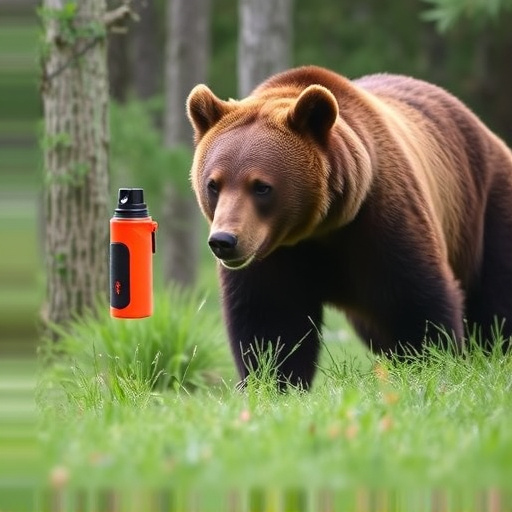Understanding bear behavior, especially charging patterns of grizzlies, is crucial for safety in wilderness areas. Bear spray is a powerful tool for deterrence and time buying against these charges, but its application varies by species and intensity. Key precautions include correct usage techniques, regular maintenance, easy accessibility, making loud noises to deter bears, minimizing scent trails, and securing food storage in bear-resistant containers. Staying informed about local bear behaviors ensures informed decisions during potential encounters.
In the vast wilderness, encountering a bear can be a terrifying prospect, but understanding their behavior is key to survival. This comprehensive guide explores the art of co-existing with these majestic creatures, focusing on bear spray as a protective measure against charging grizzlies and other species. We delve into the science behind bear attacks, offering insights on recognizing patterns and triggers. Additionally, we provide practical tips for effective use and safety precautions of bear spray, ensuring your wilderness survival.
- Understanding Bear Behavior: Recognizing Patterns and Triggers
- Bear Spray 101: Effective Use and Safety Precautions
- Charging Grizzly vs. Other Bear Species: What You Need to Know
- Additional Protective Measures: Beyond Bear Spray for Wilderness Survival
Understanding Bear Behavior: Recognizing Patterns and Triggers
Understanding bear behavior is crucial for anyone venturing into wilderness areas known for bear habitation. Recognizing patterns and triggers can significantly enhance safety during encounters. Bears, especially grizzlies, exhibit distinct behaviors that indicate their intent. For instance, a charging grizzly bear is a clear signal of aggression, whereas bears spray (bear spray vs. charging grizzly) is often a defensive mechanism used to deter perceived threats.
Knowing when a bear might become aggressive involves observing their body language. Hissing, stomping, and swatting at the ground are warning signs. Triggers can include unexpected encounters, food sources, or even perceived threats to their cubs. Understanding these cues allows hikers and campers to take appropriate action, such as backing away slowly, using bear spray effectively, or making loud noises to deter bears from approaching.
Bear Spray 101: Effective Use and Safety Precautions
Bear spray, also known as bear repellent, is a popular and effective tool for wilderness survival in areas inhabited by bears. When faced with an encounter, understanding its proper use can be life-saving. Bear spray is designed to create a barrier of chemicals that deter bears from approaching or attacking. It’s important to note that while bear spray isn’t guaranteed to stop a charging grizzly bear, it significantly increases your chances of escape and safety.
For optimal effectiveness, always follow the safety precautions. This includes ensuring proper application techniques, such as holding the canister upright and spraying in an S-pattern at close range (around 20-30 feet). Regular maintenance of the spray is crucial; check expiration dates and ensure no obstructions block the nozzle. It’s also vital to keep bear spray readily accessible, as bears can charge unexpectedly. Always store it near your hiking gear or within easy reach during outdoor activities.
Charging Grizzly vs. Other Bear Species: What You Need to Know
When encountering a charging bear, understanding the behavior and motivation behind its actions is crucial for your survival. The concept of a “charging grizzly” is often associated with North America’s iconic grizzly bears (Ursus arctos horribilis). These powerful animals are known for their aggressive defense of food sources or cubs, leading to sudden charges at high speeds. However, it’s essential to note that not all bear species exhibit such behavior. Black bears (Ursus americanus), for instance, typically avoid human confrontation and may simply retreat if they perceive a threat.
In the context of bear attacks, one common defense mechanism discussed is the use of bear spray versus a charging grizzly. Bear spray, an aerosol irritant designed to deter bears, can be effective against both grizzlies and black bears. The key difference lies in the intensity and proximity of the encounter. Grizzly bears may require a direct and potent spray application to discourage them from charging, whereas black bears might respond more to a spray from a distance or when they are not actively attacking. Always stay informed about local bear species and their behaviors to make informed decisions during potential encounters.
Additional Protective Measures: Beyond Bear Spray for Wilderness Survival
In addition to bear spray, which is a common go-to for wilderness survival against charging grizzlies, several other protective measures can significantly enhance safety in bear country. One effective method is to make noise while traveling through known bear habitats. Making loud noises like talking, singing, or clapping can deter bears from approaching unexpectedly.
Another crucial strategy involves minimizing scent trails and properly storing food. Bears have an exceptional sense of smell, so it’s essential to use bear-resistant containers for all food items. When camping, set up a secure food storage area elevated off the ground and away from your sleeping quarters. This reduces the likelihood of attracting bears that might otherwise be drawn by odors or scattered food remnants.
In the event of a potential bear attack, understanding bear behavior and employing effective protection methods like bear spray are crucial for wilderness survival. While bear spray is an essential tool against charging grizzlies and other species, it’s only one part of a comprehensive safety strategy. By recognizing patterns, staying informed about different bear behaviors, and taking additional protective measures, you can significantly enhance your chances of staying safe in bear country. Remember, knowledge and preparation are key to navigating these encounters successfully.
